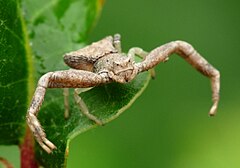| Pistius truncatus | |
|---|---|

| |
| Female | |
|
Scientific classification
| |
| Domain: | Eukaryota |
| Kingdom: | Animalia |
| Phylum: | Arthropoda |
| Subphylum: | Chelicerata |
| Class: | Arachnida |
| Order: | Araneae |
| Infraorder: | Araneomorphae |
| Family: | Thomisidae |
| Genus: | Pistius |
| Species: | P. truncatus
|
| Binomial name | |
| Pistius truncatus (Pallas, 1772)
| |
Pistius truncatus is a species of crab spiders belonging to the family Thomisidae. [1] [2]

Description
Pistius truncatus can reach a length of about 4–5 millimetres (0.16–0.20 in) in males, while females can reach 8–9 millimetres (0.31–0.35 in). The spider has small eyes and abdomen is much widened in females. [3]
Adults can be found from May to June. [4]
Distribution and habitat
This species has a palaearctic distribution. It is widespread in central and western Europe. [5] It occurs in bushes, mainly in small scrubby oaks and in forest edges. [4]
References
- ^ Biolib
- ^ Norman I. Platnick The World Spider Catalog
- ^ India, Zoological Survey of (1971). Memoirs of the Zoological Survey of India. Manager of Publications.
- ^ a b British Spiders
- ^ Fauna europaea
| Pistius truncatus | |
|---|---|

| |
| Female | |
|
Scientific classification
| |
| Domain: | Eukaryota |
| Kingdom: | Animalia |
| Phylum: | Arthropoda |
| Subphylum: | Chelicerata |
| Class: | Arachnida |
| Order: | Araneae |
| Infraorder: | Araneomorphae |
| Family: | Thomisidae |
| Genus: | Pistius |
| Species: | P. truncatus
|
| Binomial name | |
| Pistius truncatus (Pallas, 1772)
| |
Pistius truncatus is a species of crab spiders belonging to the family Thomisidae. [1] [2]

Description
Pistius truncatus can reach a length of about 4–5 millimetres (0.16–0.20 in) in males, while females can reach 8–9 millimetres (0.31–0.35 in). The spider has small eyes and abdomen is much widened in females. [3]
Adults can be found from May to June. [4]
Distribution and habitat
This species has a palaearctic distribution. It is widespread in central and western Europe. [5] It occurs in bushes, mainly in small scrubby oaks and in forest edges. [4]
References
- ^ Biolib
- ^ Norman I. Platnick The World Spider Catalog
- ^ India, Zoological Survey of (1971). Memoirs of the Zoological Survey of India. Manager of Publications.
- ^ a b British Spiders
- ^ Fauna europaea